
|
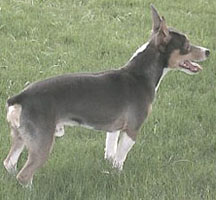
|
There have been so many questions on the color apricot and lemon its
not funny.
How do you tell an apricot pup from a lemon pup?
There are pups born white and then get an apricot or lemon color with a black nose, then there are some born white that develop the same color yet have a blue nose and then there are the ones who develop the chocolate nose. What can be said with certainty is that the nose color will dictate what color lies underneath.
If the nose is blue the dog carries double blue. If the nose is chocolate
then the dog carries double chocolate and if he has a black nose he carries
neither chocolate nor blue.
But .....what we now have essentially is a Blue Lemon,
a dog that was born white yet has recessive blue, a Chocolate Lemon,
a dog born white yet has recessive chocolate and a Blue Apricot,
a dog that was born with color but has a blue nose.
Or a dog that has a chocolate nose and was born with color which makes them a Chocolate Apricot because they have a double recessive chocolate or Apricot, a dog born with color but has neither chocolate nor blue with a black nose.
Then there is the Lemon who is born white but has a black nose.
The NRTA has designated pups born white are of the lemon series if you will and the pups born with color are of the apricot colors. That is regardless of what color there nose is. We then place the blue or chocolate prefix before the color when necessary.
How on earth does this all get sorted out??
The NRTA goes by the genetics that the parents carry and
to the best of our ability give them the proper formula. It is unclear
what particular gene lets a pup be born white while others are not yet
turn the same shade of color. There are several theories why this happens
but its not so much why it happens its what do we call them. We have
come to see that certain lines will throw this white pup that turns up
with color while other lines do not. Perhaps it is a particular dog that
was in the makeup early on in the development. Some Rats have it and some
don't even when both the white pups and the pups that develop color can
happen in the same litter. So for sanity sake we have called those that
are born white lemons and those born with color apricots.
In reality or rather in genetic theory and formulation the color apricot does not have the same formula as what we are calling apricot and lemon in our breed. Rather the color apricot is technically called Clear Red and lemon is called Lemon which both have the exact same formula. But people see the color apricot which is very descriptive of the color in a lot of instances and in other the color Lemon is more descriptive. To further complicate things the color Lemon is designated in certain breeds to dogs that look lemon in color but have a chocolate nose.
So what do we do??? Maybe go by Clear Red for dogs that are born with
color and have a black nose. A dog that is born white and has a black nose
and gets color later a Lemon. Those that are born with color and have a
chocolate nose or blue nose should be Chocolate Apricot and Blue Apricot
and those that are born white and have a chocolate or blue nose should
be called Chocolate Lemon and Blue Lemon. Sounds reasonable doesn’t it?
There is very clear delineation that way and is fairly easy to keep track
of.

|

|
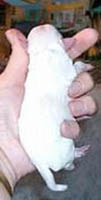
Newborn Cookie |
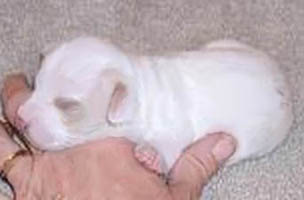
Cookie at 2 weeks, you can see the rather dramatic change between 2 and 3 weeks. Note the lack of color pigment in the nose |
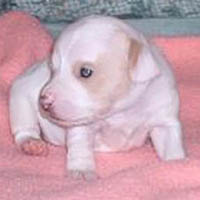
|
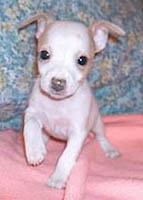
Cookie at 6 weeks, the color is coming into the nose now. |
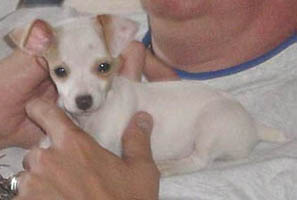
8 weeks of age |
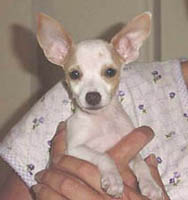
Now 12 weeks, nose color is complete and full color has developed |
|
|

Longs Dusty |
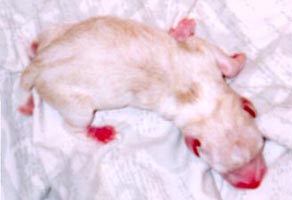
This is Dusty at birth, as you can see there is not much color but not pure white. |
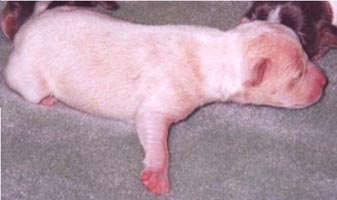
Dusty is starting to develop more color. |
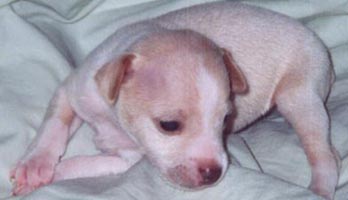
Note the nose color coming now. The final color was a blue shade. |
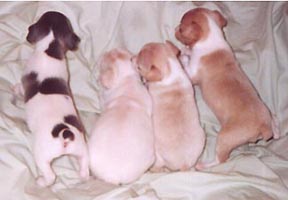
This is Dustys litter mates. You would think That Dusty is the pup on the right, but indeed he is the one in the middle. This litter was born white, but started coloring up within 30 minutes. His nose is not black and it is not self-colored. His nose is blue/dark gray. Cheryl Long, AZ |
|
|
|

Fern Hill Roxy, mother |

Monterey Diamond, father |
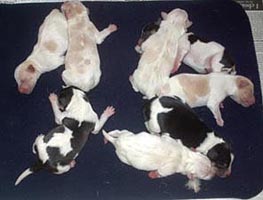
Newborn litter showing the white and the ones with some color at birth. |
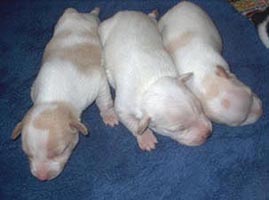
Roxy's litter at about 2 weeks |
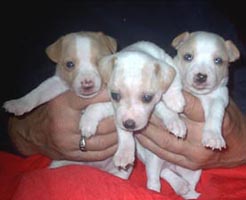 |
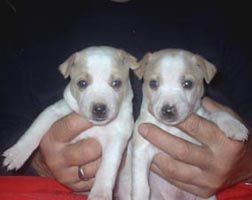 |